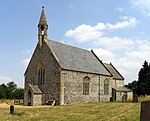Wayland Rural District
Districts of England abolished by the Local Government Act 1972Districts of England created by the Local Government Act 1894Historical districts of NorfolkRural districts of EnglandUse British English from June 2017

Wayland Rural District was a rural district in Norfolk, England from 1894 to 1974.It was formed under the Local Government Act 1894 based on the Wayland rural sanitary district, taking its name from the ancient Wayland hundred. It lay in the central southern part of the county. In 1902 it took in the northern part of the disbanded Guiltcross Rural District, and in 1935 the eastern section of the disbanded Thetford Rural District (much of which had also been transferred from Guiltcross RD). In 1974, the district was abolished under the Local Government Act 1972, and became part of the Breckland district.
Excerpt from the Wikipedia article Wayland Rural District (License: CC BY-SA 3.0, Authors, Images).Wayland Rural District
Attleborough Road, Breckland District Caston
Geographical coordinates (GPS) Address Nearby Places Show on map
Geographical coordinates (GPS)
| Latitude | Longitude |
|---|---|
| N 52.54 ° | E 0.88 ° |
Address
Attleborough Road
Attleborough Road
NR17 1DW Breckland District, Caston
England, United Kingdom
Open on Google Maps






